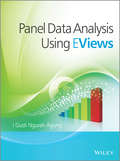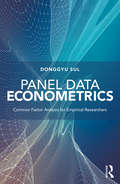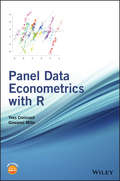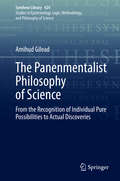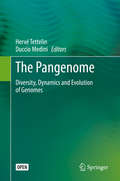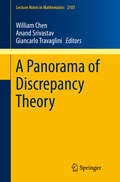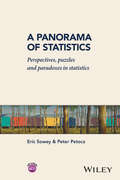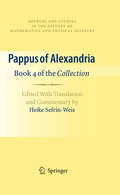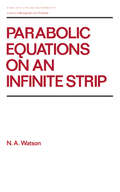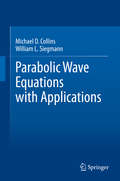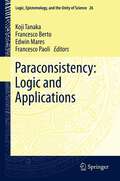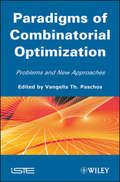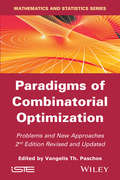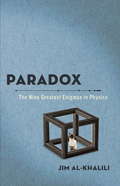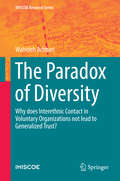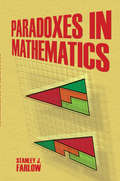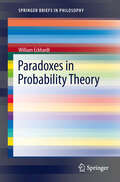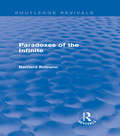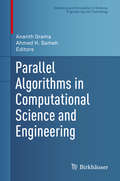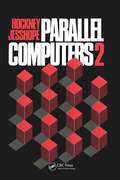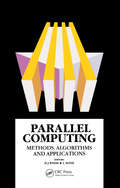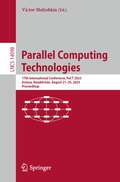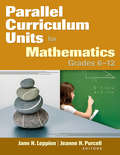- Table View
- List View
Pandemics: Insurance and Social Protection (Springer Actuarial)
by María del Carmen Boado-Penas Julia Eisenberg Şule ŞahinThis open access book collects expert contributions on actuarial modelling and related topics, from machine learning to legal aspects, and reflects on possible insurance designs during an epidemic/pandemic.Starting by considering the impulse given by COVID-19 to the insurance industry and to actuarial research, the text covers compartment models, mortality changes during a pandemic, risk-sharing in the presence of low probability events, group testing, compositional data analysis for detecting data inconsistencies, behaviouristic aspects in fighting a pandemic, and insurers’ legal problems, amongst others.Concluding with an essay by a practicing actuary on the applicability of the methods proposed, this interdisciplinary book is aimed at actuaries as well as readers with a background in mathematics, economics, statistics, finance, epidemiology, or sociology.
Panel Data Analysis using EViews
by I Gusti AgungA comprehensive and accessible guide to panel data analysis using EViews softwareThis book explores the use of EViews software in creating panel data analysis using appropriate empirical models and real datasets. Guidance is given on developing alternative descriptive statistical summaries for evaluation and providing policy analysis based on pool panel data. Various alternative models based on panel data are explored, including univariate general linear models, fixed effect models and causal models, and guidance on the advantages and disadvantages of each one is given.Panel Data Analysis using EViews:Provides step-by-step guidance on how to apply EViews software to panel data analysis using appropriate empirical models and real datasets. Examines a variety of panel data models along with the author's own empirical findings, demonstrating the advantages and limitations of each model.Presents growth models, time-related effects models, and polynomial models, in addition to the models which are commonly applied for panel data.Includes more than 250 examples divided into three groups of models (stacked, unstacked, and structured panel data), together with notes and comments.Provides guidance on which models not to use in a given scenario, along with advice on viable alternatives.Explores recent new developments in panel data analysisAn essential tool for advanced undergraduate or graduate students and applied researchers in finance, econometrics and population studies. Statisticians and data analysts involved with data collected over long time periods will also find this book a useful resource.
Panel Data Econometrics: Common Factor Analysis for Empirical Researchers
by Donggyu SulIn the last 20 years, econometric theory on panel data has developed rapidly, particularly for analyzing common behaviors among individuals over time. Meanwhile, the statistical methods employed by applied researchers have not kept up-to-date. This book attempts to fill in this gap by teaching researchers how to use the latest panel estimation methods correctly. Almost all applied economics articles use panel data or panel regressions. However, many empirical results from typical panel data analyses are not correctly executed. This book aims to help applied researchers to run panel regressions correctly and avoid common mistakes. The book explains how to model cross-sectional dependence, how to estimate a few key common variables, and how to identify them. It also provides guidance on how to separate out the long-run relationship and common dynamic and idiosyncratic dynamic relationships from a set of panel data. Aimed at applied researchers who want to learn about panel data econometrics by running statistical software, this book provides clear guidance and is supported by a full range of online teaching and learning materials. It includes practice sections on MATLAB, STATA, and GAUSS throughout, along with short and simple econometric theories on basic panel regressions for those who are unfamiliar with econometric theory on traditional panel regressions.
Panel Data Econometrics with R
by Giovanni Millo Yves CroissantPanel Data Econometrics with R provides a tutorial for using R in the field of panel data econometrics. Illustrated throughout with examples in econometrics, political science, agriculture and epidemiology, this book presents classic methodology and applications as well as more advanced topics and recent developments in this field including error component models, spatial panels and dynamic models. They have developed the software programming in R and host replicable material on the book’s accompanying website.
The Panenmentalist Philosophy of Science: From the Recognition of Individual Pure Possibilities to Actual Discoveries (Synthese Library #424)
by Amihud GileadThis book presents a philosophy of science, based on panenmentalism: an original modal metaphysics, which is realist about individual pure (non-actual) possibilities and rejects the notion of possible worlds. The book systematically constructs a new and novel way of understanding and explaining scientific progress, discoveries, and creativity. It demonstrates that a metaphysics of individual pure possibilities is indispensable for explaining and understanding mathematics and natural sciences. It examines the nature of individual pure possibilities, actualities, mind-dependent and mind-independent possibilities, as well as mathematical entities. It discusses in detail the singularity of each human being as a psychical possibility. It analyses striking scientific discoveries, and illustrates by means of examples of the usefulness and vitality of individual pure possibilities in the sciences.
The Pangenome: Diversity, Dynamics and Evolution of Genomes
by Hervé Tettelin Duccio MediniThis open access book offers the first comprehensive account of the pan-genome concept and its manifold implications. The realization that the genetic repertoire of a biological species always encompasses more than the genome of each individual is one of the earliest examples of big data in biology that opened biology to the unbounded. The study of genetic variation observed within a species challenges existing views and has profound consequences for our understanding of the fundamental mechanisms underpinning bacterial biology and evolution. The underlying rationale extends well beyond the initial prokaryotic focus to all kingdoms of life and evolves into similar concepts for metagenomes, phenomes and epigenomes. The book’s respective chapters address a range of topics, from the serendipitous emergence of the pan-genome concept and its impacts on the fields of microbiology, vaccinology and antimicrobial resistance, to the study of microbial communities, bioinformatic applications and mathematical models that tie in with complex systems and economic theory. Given its scope, the book will appeal to a broad readership interested in population dynamics, evolutionary biology and genomics.
A Panorama of Discrepancy Theory (Lecture Notes in Mathematics #2107)
by Giancarlo Travaglini William Chen Anand SrivastavThis is the first work on Discrepancy Theory to show the present variety of points of view and applications covering the areas Classical and Geometric Discrepancy Theory, Combinatorial Discrepancy Theory and Applications and Constructions. It consists of several chapters, written by experts in their respective fields and focusing on the different aspects of the theory. Discrepancy theory concerns the problem of replacing a continuous object with a discrete sampling and is currently located at the crossroads of number theory, combinatorics, Fourier analysis, algorithms and complexity, probability theory and numerical analysis. This book presents an invitation to researchers and students to explore the different methods and is meant to motivate interdisciplinary research.
A Panorama of Statistics: Perspectives, Puzzles and Paradoxes in Statistics
by Eric Sowey Peter PetoczThis book is a stimulating panoramic tour – quite different from a textbook journey – of the world of statistics in both its theory and practice, for teachers, students and practitioners.At each stop on the tour, the authors investigate unusual and quirky aspects of statistics, highlighting historical, biographical and philosophical dimensions of this field of knowledge. Each chapter opens with perspectives on its theme, often from several points of view. Five original and thought-provoking questions follow. These aim at widening readers’ knowledge and deepening their insight. Scattered among the questions are entertaining puzzles to solve and tantalising paradoxes to explain. Readers can compare their own statistical discoveries with the authors’ detailed answers to all the questions. The writing is lively and inviting, the ideas are rewarding, and the material is extensively cross-referenced. A Panorama of Statistics: Leads readers to discover the fascinations of statistics. Is an enjoyable companion to an undergraduate statistics textbook. Is an enriching source of knowledge for statistics teachers and practitioners. Is unique among statistics books today for its memorable content and engaging style. Lending itself equally to reading through and to dipping into, A Panorama of Statistics will surprise teachers, students and practitioners by the variety of ways in which statistics can capture and hold their interest.Reviews:"As befits the authors' statement that 'this is not a textbook', the structure is unusual. There are twenty-five chapters organised in five sections, each beginning with a brief perspective of a theme in statistics and finishing with five questions related to that theme. The answers provided to the questions, in section six, are as discursive and illuminating as the main body of the text. Even if you are pretty sure you know the answer, it is always worth checking what the authors have to say. Chances are that you will learn something every time. The glimpses and insights given into this enormous and far-reaching discipline succeed in being bewitching, entertaining and inviting; coverage was never the aim." "In summary, this splendid book lives up to the four 'p-values' of its title. It is panoramic in the scope of its survey of statistics, it is full of illuminating perspectives, it sets entertaining and challenging puzzles, and it explores fascinating paradoxes. Read it, enjoy it and learn from it."From Neil Sheldon, Teaching Statistics, volume 9, no. 2, May 2017
Pappus of Alexandria: Book 4 of the Collection
by Heike Sefrin-WeisAlthough not so well known today, Book 4 of Pappus' Collection is one of the most important and influential mathematical texts from antiquity. The mathematical vignettes form a portrait of mathematics during the Hellenistic "Golden Age", illustrating central problems - for example, squaring the circle; doubling the cube; and trisecting an angle - varying solution strategies, and the different mathematical styles within ancient geometry. This volume provides an English translation of Collection 4, in full, for the first time, including: a new edition of the Greek text, based on a fresh transcription from the main manuscript and offering an alternative to Hultsch's standard edition, notes to facilitate understanding of the steps in the mathematical argument, a commentary highlighting aspects of the work that have so far been neglected, and supporting the reconstruction of a coherent plan and vision within the work, bibliographical references for further study.
Parabolic Equations on an Infinite Strip (Chapman And Hall/crc Pure And Applied Mathematics Ser. #127)
by WatsonThis book focuses on solutions of second order, linear, parabolic, partial differentialequations on an infinite strip-emphasizing their integral representation, their initialvalues in several senses, and the relations between these.Parabolic Equations on an Infinite Strip provides valuable information-previously unavailable in a single volume-on such topics as semigroup property.. . the Cauchy problem ... Gauss-Weierstrass representation . .. initial limits .. .normal limits and related representation theorems ... hyperplane conditions .. .determination of the initial measure .. . and the maximum principle. It also exploresnew, unpublished results on parabolic limits . . . more general limits ... and solutionssatisfying LP conditions.Requiring only a fundamental knowledge of general analysis and measure theory, thisbook serves as an excellent text for graduate students studying partial differentialequations and harmonic analysis, as well as a useful reference for analysts interested inapplied measure theory, and specialists in partial differential equations.
Parabolic Wave Equations with Applications
by Michael D. Collins William L. SiegmannThis book introduces parabolic wave equations, their key methods of numerical solution, and applications in seismology and ocean acoustics. The parabolic equation method provides an appealing combination of accuracy and efficiency for many nonseparable wave propagation problems in geophysics. While the parabolic equation method was pioneered in the 1940s by Leontovich and Fock who applied it to radio wave propagation in the atmosphere, it thrived in the 1970s due to its usefulness in seismology and ocean acoustics. The book covers progress made following the parabolic equation’s ascendancy in geophysics. It begins with the necessary preliminaries on the elliptic wave equation and its analysis from which the parabolic wave equation is derived and introduced. Subsequently, the authors demonstrate the use of rational approximation techniques, the Padé solution in particular, to find numerical solutions to the energy-conserving parabolic equation, three-dimensional parabolic equations, and horizontal wave equations. The rest of the book demonstrates applications to seismology, ocean acoustics, and beyond, with coverage of elastic waves, sloping interfaces and boundaries, acousto-gravity waves, and waves in poro-elastic media. Overall, it will be of use to students and researchers in wave propagation, ocean acoustics, geophysical sciences and more.
Paraconsistency: Logic and Applications
by Edwin Mares Francesco Berto Francesco Paoli Koji TanakaA logic is called 'paraconsistent' if it rejects the rule called 'ex contradictione quodlibet', according to which any conclusion follows from inconsistent premises. While logicians have proposed many technically developed paraconsistent logical systems and contemporary philosophers like Graham Priest have advanced the view that some contradictions can be true, and advocated a paraconsistent logic to deal with them, until recent times these systems have been little understood by philosophers. This book presents a comprehensive overview on paraconsistent logical systems to change this situation. The book includes almost every major author currently working in the field. The papers are on the cutting edge of the literature some of which discuss current debates and others present important new ideas. The editors have avoided papers about technical details of paraconsistent logic, but instead concentrated upon works that discuss more "big picture" ideas. Different treatments of paradoxes takes centre stage in many of the papers, but also there are several papers on how to interpret paraconistent logic and some on how it can be applied to philosophy of mathematics, the philosophy of language, and metaphysics.
Paradigms of Combinatorial Optimization: Problems and New Approaches, Volume 2 (Wiley-iste Ser.)
by Vangelis Th. PaschosCombinatorial optimization is a multidisciplinary scientific area, lying in the interface of three major scientific domains: mathematics, theoretical computer science and management. The three volumes of the Combinatorial Optimization series aims to cover a wide range of topics in this area. These topics also deal with fundamental notions and approaches as with several classical applications of combinatorial optimization. “Paradigms of Combinatorial Optimization” is divided in two parts: • Paradigmatic Problems, that handles several famous combinatorial optimization problems as max cut, min coloring, optimal satisfiability tsp, etc., the study of which has largely contributed to both the development, the legitimization and the establishment of the Combinatorial Optimization as one of the most active actual scientific domains; • Classical and New Approaches, that presents the several methodological approaches that fertilize and are fertilized by Combinatorial optimization such as: Polynomial Approximation, Online Computation, Robustness, etc., and, more recently, Algorithmic Game Theory.
Paradigms of Combinatorial Optimization: Problems and New Approaches (Wiley-iste Ser.)
by Vangelis Th. PaschosCombinatorial optimization is a multidisciplinary scientific area, lying in the interface of three major scientific domains: mathematics, theoretical computer science and management. The three volumes of the Combinatorial Optimization series aim to cover a wide range of topics in this area. These topics also deal with fundamental notions and approaches as with several classical applications of combinatorial optimization. Concepts of Combinatorial Optimization, is divided into three parts: - On the complexity of combinatorial optimization problems, presenting basics about worst-case and randomized complexity; - Classical solution methods, presenting the two most-known methods for solving hard combinatorial optimization problems, that are Branch-and-Bound and Dynamic Programming; - Elements from mathematical programming, presenting fundamentals from mathematical programming based methods that are in the heart of Operations Research since the origins of this field.
Paradox
by Jim Al-KhaliliA fun and fascinating look at great scientific paradoxes. Throughout history, scientists have come up with theories and ideas that just don't seem to make sense. These we call paradoxes. The paradoxes Al-Khalili offers are drawn chiefly from physics and astronomy and represent those that have stumped some of the finest minds. For example, how can a cat be both dead and alive at the same time? Why will Achilles never beat a tortoise in a race, no matter how fast he runs? And how can a person be ten years older than his twin? With elegant explanations that bring the reader inside the mind of those who've developed them, Al-Khalili helps us to see that, in fact, paradoxes can be solved if seen from the right angle. Just as surely as Al-Khalili narrates the enduring fascination of these classic paradoxes, he reveals their underlying logic. In doing so, he brings to life a select group of the most exciting concepts in human knowledge. Paradox is mind-expanding fun.
The Paradox of Diversity
by Wahideh AchbariThis book is about ethnic diversity in voluntary organizations and seeks to explain whether intergroup contact contributes to the development of generalized trust. It relies on a novel multilevel design and data from Amsterdam in which 40 voluntary organizations and 463 participants have been sampled. Contrary to conventional wisdom, this book argues that cognitive processes are contributing more toward the evaluation of strangers or generalized trust than interethnic contact. Since trusting unknown people is essentially a risky endeavor, this suggests that participants of both association types who report trusting strangers can afford to do so, because they are better educated, have a more positive worldview, and have had fewer negative life experiences. That is to say, they are socially more successful and view their future as more promising. Previous findings are inconclusive since most studies that conclude diversity has led to less generalized trust do not include interethnic contact directly in their analyses. These studies also downplay the importance of cognitive processes, which may shape generalized trust. What is more, people join ethnically diverse civic groups, because they already have more trustful attitudes, rather than learning to trust through interethnic contact. Despite the recent multiculturalist backlash, this book demonstrates that participation in ethno-national organizations does not pose a threat to social cohesion. The analysis in this book serves to build a general theory of trust that moves beyond emphasizing interaction between people who are different from each other, but one that includes the importance of cognition.
Paradoxes and Inconsistent Mathematics
by Zach WeberLogical paradoxes – like the Liar, Russell's, and the Sorites – are notorious. But in Paradoxes and Inconsistent Mathematics, it is argued that they are only the noisiest of many. Contradictions arise in the everyday, from the smallest points to the widest boundaries. In this book, Zach Weber uses “dialetheic paraconsistency” – a formal framework where some contradictions can be true without absurdity – as the basis for developing this idea rigorously, from mathematical foundations up. In doing so, Weber directly addresses a longstanding open question: how much standard mathematics can paraconsistency capture? The guiding focus is on a more basic question, of why there are paradoxes. Details underscore a simple philosophical claim: that paradoxes are found in the ordinary, and that is what makes them so extraordinary.
Paradoxes in Mathematics (Dover Books on Mathematics)
by Stanley J. FarlowThere's more than one way to define a paradox, and this intriguing book offers examples of every kind. Stanley J. Farlow, a prominent educator and author, presents a captivating mix of mathematical paradoxes: the kind with surprising, nonintuitive outcomes; the variety that rely on mathematical sleight-of-hand to impress the unwary observer; and the baffling type with a solution that passes all understanding.Students and puzzle enthusiasts will find plenty of thought-provoking enjoyment mixed with a bit of painless mathematical instruction among these twenty-eight conundrums. Some of them involve counting, some deal with infinity, and others draw on principles of geometry and arithmetic. None requires an extensive background in higher mathematics. Challenges include The Curve That Shook the World, a variation on the famous Monty Hall Problem, Space Travel in a Wineglass, Through Cantor's Looking Glass, and other fun-to-ponder paradoxes.
Paradoxes in Probability Theory
by William EckhardtParadoxes provide a vehicle for exposing misinterpretations and misapplications of accepted principles. This book discusses seven paradoxes surrounding probability theory. Some remain the focus of controversy; others have allegedly been solved, however the accepted solutions are demonstrably incorrect. Each paradox is shown to rest on one or more fallacies. Instead of the esoteric, idiosyncratic, and untested methods that have been brought to bear on these problems, the book invokes uncontroversial probability principles, acceptable both to frequentists and subjectivists. The philosophical disputation inspired by these paradoxes is shown to be misguided and unnecessary; for instance, startling claims concerning human destiny and the nature of reality are directly related to fallacious reasoning in a betting paradox, and a problem analyzed in philosophy journals is resolved by means of a computer program.
Paradoxes of the Infinite (Routledge Revivals)
by Bernard BolzanoParadoxes of the Infinite presents one of the most insightful, yet strangely unacknowledged, mathematical treatises of the 19th century: Dr Bernard Bolzano’s Paradoxien. This volume contains an adept translation of the work itself by Donald A. Steele S.J., and in addition an historical introduction, which includes a brief biography as well as an evaluation of Bolzano the mathematician, logician and physicist.
Parallel Algorithms in Computational Science and Engineering (Modeling and Simulation in Science, Engineering and Technology)
by Ananth Grama Ahmed H. SamehThis contributed volume highlights two areas of fundamental interest in high-performance computing: core algorithms for important kernels and computationally demanding applications. The first few chapters explore algorithms, numerical techniques, and their parallel formulations for a variety of kernels that arise in applications. The rest of the volume focuses on state-of-the-art applications from diverse domains. By structuring the volume around these two areas, it presents a comprehensive view of the application landscape for high-performance computing, while also enabling readers to develop new applications using the kernels. Readers will learn how to choose the most suitable parallel algorithms for any given application, ensuring that theory and practicality are clearly connected. Applications using these techniques are illustrated in detail, including:Computational materials science and engineeringComputational cardiovascular analysisMultiscale analysis of wind turbines and turbomachineryWeather forecastingMachine learning techniquesParallel Algorithms in Computational Science and Engineering will be an ideal reference for applied mathematicians, engineers, computer scientists, and other researchers who utilize high-performance computing in their work.
Parallel Computers 2: Architecture, Programming and Algorithms
by R.W Hockney C.R JesshopeSince the publication of the first edition, parallel computing technology has gained considerable momentum. A large proportion of this has come from the improvement in VLSI techniques, offering one to two orders of magnitude more devices than previously possible. A second contributing factor in the fast development of the subject is commercialization. The supercomputer is no longer restricted to a few well-established research institutions and large companies. A new computer breed combining the architectural advantages of the supercomputer with the advance of VLSI technology is now available at very attractive prices. A pioneering device in this development is the transputer, a VLSI processor specifically designed to operate in large concurrent systems. Parallel Computers 2: Architecture, Programming and Algorithms reflects the shift in emphasis of parallel computing and tracks the development of supercomputers in the years since the first edition was published. It looks at large-scale parallelism as found in transputer ensembles. This extensively rewritten second edition includes major new sections on the transputer and the OCCAM language. The book contains specific information on the various types of machines available, details of computer architecture and technologies, and descriptions of programming languages and algorithms. Aimed at an advanced undergraduate and postgraduate level, this handbook is also useful for research workers, machine designers, and programmers concerned with parallel computers. In addition, it will serve as a guide for potential parallel computer users, especially in disciplines where large amounts of computer time are regularly used.
Parallel Computing: Methods, Algorithms and Applications
by David J Evans; C SuttiParallel Computing: Methods, Algorithms and Applications presents a collection of original papers presented at the international meeting on parallel processing, methods, algorithms, and applications at Verona, Italy in September 1989.
Parallel Computing Technologies: 17th International Conference, PaCT 2023, Astana, Kazakhstan, August 21–25, 2023, Proceedings (Lecture Notes in Computer Science #14098)
by Victor MalyshkinThis book constitutes the refereed proceedings of the 17th International Conference on Parallel Computing Technologies, PaCT 2023, held in Astana, Kazakhstan, during August 21-25, 2023. The 15 full papers included in this book were carefully reviewed and selected from 23 submissions. They were organized in topical sections as follows: automatic programming and program tuning; frameworks and services; algorithms; and distributed systems management.
Parallel Curriculum Units for Mathematics, Grades 6–12
by Dr Jann H. Leppien Dr Jeanne H. PurcellMaximize your mathematics curriculum to challenge all students This collection of lessons from experienced teachers provides multifaceted examples of rigorous learning opportunities for mathematics students in Grades 6–12. The four sample units focus on fractions, linear programming, geometry, and quadratic relationships. The authors provide user-friendly methods for instruction and demonstrate how to differentiate the lessons for the benefit of all students. Included are standards-based strategies that guide students through: Understanding secondary mathematics concepts Discovering connections between mathematics and other subjects Developing critical thinking skills Connecting mathematics learning to society through the study of real-world data, proportional reasoning, and problem solving

